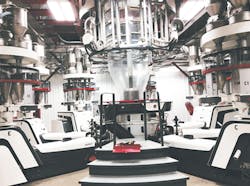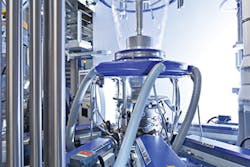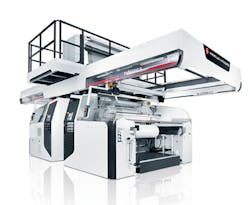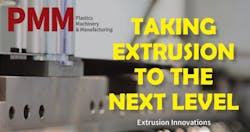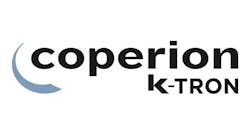At Next Generation Films Inc., Lexington, Ohio, executives are following through on aggressive growth plans with key investments in state-of-the-art technology, which include Windmöller & Hölscher and Hosokawa Alpine American blown film lines and their supporting winders in the Filmatic and Alpine/Kolb brands, respectively.
In 2015, Next officials will spend north of $30 million in equipment investments.
At a tour of its facilities in December, CEO Dave Frecka walked PMM through each plant — six in
total — all located on the same street in Lexington, Ohio, covering some 350 acres and more than 400,000 square feet. The company will grow to eight plants by 2016 — the two new additions will be another film plant and a 200,000-square foot warehouse that will be fully automated from shelf to truck. Frecka shows off the facilities — he alone leads the tour — but he is extremely guarded on the technologies. To get the anatomy of one entire blown film line is like asking Frecka to tell his deepest, most valued secret. Suppliers also are sworn to secrecy.
Frecka oversees the entire operation as chairman and CEO and is supported at the executive level by President Dan Niss and Dave Bubar, CFO. Fundamentally, it is a family-oriented business that is privately held with a goal of reaching $500 million in sales in the next few years.
"I do not want to define any technologies that [will] take us there," Frecka says. "Just know that many new ones will help us get there."
Here is what officials would reveal: Next Generation Films produces some 280 million pounds of specialty films annually and the output of each line constantly is being challenged. The company relies on W&H and Alpine for primary equipment and there is no commingling of parts. For example, a W&H line will have a W&H die and an Alpine line will have an Alpine die. The equipment is tinkered with until Frecka and crew find the right flow to maximize output and physical properties. Next Generation uses grooved feed technology on the extruders. For drying and other auxiliary functions, a mix of equipment brands is used including AEC.
"You're using pressure and heat to make that polymer and get it moved forward, so at the end of the day, your film will have more strength, less shear," Frecka says of the grooved feed technology.
The films primarily go into food packaging but some also goes into other consumer applications, including the plastic packaging for napkins; automotive and other industrial applications. Food packaging is growing at a healthy pace, thanks in part to changing consumer preferences and the technologies in barrier films. According to Smithers Pira, Surrey, England, the consumption of global high-barrier packaging is forecast to grow at a compounded annual rate of 5 percent between 2014 and 2019. In 2014, the global consumption roughly was 1.76 million metric tons with a value of $15.9 billion. On the growth of food packaging alone, Next Generation has to add one line per year just to keep pace. Next Generation also is taking market share from competitors all in the name of sustainability.
"All that business that we've taken, we've downgauged someone else's film 30 to 40 percent. It's getting thinner and stronger. There is a lot more power in downgauging than recycling," Frecka says.
Frecka, though, insists that the mix for success depends on so many factors.
"Asking for the right resin pellet, getting highest output, consistency and continuity and training our people, also finding a customer that has a culture similar to ours. The business cannot merely be transactional," he says.
The recipe for each material formulation on each line is tracked carefully with 100 percent traceability. The standards are getting more stringent, especially in the production of food films. What has changed mostly in the 20 years since he started the company is that there is more control over the process, more computerization and more refinement.
Line review
At the time of PMM's visit, there were 36 blown film lines producing three-, five-, seven- and nine-layer films used in every market from food to agricultural and automotive. There is no waste produced from the facilities because any scrap is re-used; for instance, scrap from the food films production plant will be re-used in the industrial plant.
"Everything feeds on everything. It's like a circle. We're just starting. I've got my people. I'm ready. We have the infrastructure in place. We are ready for the next growth spurt," he says.
Now in its 21st year of operation, Next Generation used to be all three-layer. All new capacity is five, seven or nine layers as efforts in downgauging yield results for sustainability and superior film structure which is achieved through micro-layers. What was previously extruded in a traditional three-layer structure now is being done via five layers. That may sound like a contradiction — why add layers when the goal is to downgauge? But the key is building in micro-layers to gain even more strength and flexibility in the film all the while reducing the amount of resin.
The goal is to tailor a film structure to maximize the physical properties and keep resin costs as low as possible.
The latest, patented technologies are making all of that possible, including an Alpine X Die line in a five-layer configuration that will have an Alpine/Kolb surface winder rather than a stacked turret. If the X Die sounds familiar, this is the technology that was on display at the K show in 2013. That patented die has a unique pre-distribution and spiral design that optimizes melt flow for maximum thermal homogeneity. The design facilitates channel lengths for the fastest purging and shortest possible job-changes to minimize scrap and down time. That patented spiral design also eliminates visible port lines.
The air apparent
Air ring designs carefully are considered. Think about it — what if a mishap occurred in that sacred space where the air does its magic — blowing the film into towers 60 feet high, for example. There are scholarly articles dedicated to the aerodynamics of blown film bubble cooling and blown film bubble management. Next Generation takes it very seriously.
"We play around with all different types of air rings," says Frecka. One of the lines in the plant focused on industrial films employs a triple lip design that allows the molecules to relax in the film and creates a better melt strength and flow rate.
Double air rings are employed on other lines. Determining the lip count and design of the air ring is a continual education and process, one that Frecka considers intellectual property.
"It is no simple equation, you have to start out with the film recipe first and work from there," Frecka says of the air rings. Each section of the film line has to be carefully engineered for competing in these markets and for meeting customers' demands.
"There is downgauging in every industry we're in," he says, even in agricultural films. One particular product is being boxed and although Frecka asked that PMM not disclose the customer, the marketing language on the box assures the end user that the film "meets and exceeds 6 mil performance properties for ASTM D 4397." ASTM D 4397 is the standard specification for PE sheeting for construction, industrial and agricultural applications.
Early in 2014, Frecka and executive management ordered the two Varex II blown film lines that will be used to produce barrier films, a growing market for the company. One is an 87-inch, seven-layer line and the other is a 103-inch, nine-layer, which was due to be delivered in a few weeks. The Varex II was introduced at the 2013 K show in Düsseldorf, Germany. During PMM's tour, the construction site at Next was being prepped for the nine-layer and another line that will go next to it in May. That is the five-layer from Alpine.
"That is the future," Frecka says, "barrier and breathable films. We want to do to barrier films what we've done everywhere else — make them thinner, trying to reduce all those layers and thickness and keep the same performance."
Roughly 403 employees keep the operations performing at levels that are being pushed constantly. That will increase to about 440 this year. Each building also has its own R&D lab where technicians use state-of-the-art equipment to study film structures and reverse engineer. For example, one particular microscope that doesn't actually even look like a microscope was a technology borrowed from the medical industry. Mocon units measure breathability and barrier properties.
Employees create film structures, measure them and tweak everything on a daily basis. Some recent projects include packaging for Totino's pizza rolls and film for sugar cookie dough in a trial that was done earlier in 2014, says Emma Hallett, research and development engineer. One other conversion that is being worked on is taking rigid packaging in facial tissue and converting it to film. Morningstar Farms, the company that makes meat-replacement foods for vegetarian and vegan consumers, is converting its current film used for packaging meatless nuggets.
In this plant used for food film production, workers were cleaning and polishing a portion of the floor. How the plant appears is of critical importance. Cleanliness is held in the highest regard. Next Generation recently earned an A-rating from the British Retail Consortium for its global standards in safety and quality certification. This plant has four brand-new lines, one of which is a seven layer with five-component blending on each of the extruders. The blowers, wires, air coolers and other integral components are buried underground.
To keep up with the machinery purchases is a sort of Sisyphean task. Lines constantly are being evaluated for upgrading, replacement or retirement. The oldest line is aged 14 years, a W&H 103-inch that makes industrial films.
"We do our own magic with these lines," says Frecka, who started the company in 1994. "That gives us a big competitive advantage. I can't tell you what we do to it; that is a trade secret. You have to be able to understand resins and understand polymer science. You have to look at different flow rates."
If a line isn't achieving the desired output, management will have it re-engineered, for example, a twin head design in the bag plant to produce smaller bags.
"You can't get a lot of output running one up," Frecka says. The plant eventually will accommodate 10 new five-layer lines.
One thing is certain, though, no piece of equipment is sacred. Frecka and his group consistently upgrade equipment and re-invest and that means retiring equipment that just doesn't make the grade. In the industry, this is seen as a key strength.
"Where Next has done a really good job is in the reinvestment in assets and keeping machines current," says David Nunes, president of Hosokawa Alpine American, citing a motto that Alpine often preaches: "Do not fall in love with your assets, they do not love you back."
The output in the plants is key. Large flat screen monitors within the factories showcase line output, the largest of which is in Plant 3, the food film plant. The monitor showcased the output: 2,024 pounds per hour being produced on a five-layer Varex II.
Frecka now is focused on achieving an output of more than 4,000 pounds per hour on a "super" line that will have special layers designed for the right output. That special layering designed for the right output is, like so much else, a secret.
Angie DeRosa, managing editor
